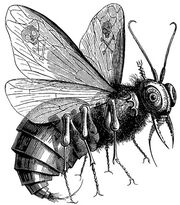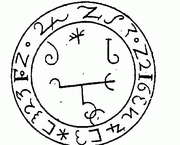
Beelzebub as depicted in Collin de Plancy's Dictionnaire Infernal (Paris, 1863).
Beelzebub (IPA|/biˈɛl.zəˌbʌb/), Ba‘al Zebûb or Ba‘al Zəvûv (Hebrew בעל זבוב, with numerous variants. In addition to Beelzebub, Ba‘al Zebûb, and Ba‘al Zəvûv, (בעל זבוב), variants include Belzebud, Beezelbub, Belzaboul, Beelzeboul, Baalsebul, Baalzebubg, Beelzebuth, and Beelzebus. Arabic: بعل الذباب, Ba‘al az-Zubab;, literally "Lord of the Flies"; Greek: Βεελζεβούλ, Velzevoúl; Latin: Beelzebūb), with numerous archaic variants, is a Semitic deity that was worshiped in the Philistine city of Ekron. Beelzebub is often linked with Satan by Christians, in demonology he is one of the seven princes of the Underworld.
Etymology[]
Ba‘al Zebûb might mean either 'Lord of Zebûb', referring to an unknown place called Zebûb, or 'Lord of flies' (zebûb being a Hebrew collective noun for 'fly'). This may mean the Hebrews were denigrating their enemies' god by referring to him as dung. Thomas Kelly Cheyne suggested that it might be a corruption of Ba'al Zebul, 'Lord of the High Place'. The SeptuagintA renders the name as Baalzeboub, SeptuagintB as Baal myîan 'Baal of flies', but Symmachus the Ebionite may have reflected a tradition of its offensive ancient name when he rendered it as Beelzeboul (Catholic Encyclopedia).
In any case the form Beelzebub was substituted for Belzebul in the Syriac translation and Latin Vulgate translation of the gospels and this substitution was repeated in the King James Version of the Bible, the result of which is the form Beelzebul was mostly unknown to western European and descendant cultures until some more recent translations restored it. In summary, it is unknown if either or both of these names were a title applied to persons, to divinities exclusively, or otherwise were a corruption of such a title, possibly as a denigration.
History[]
Antiquity[]
In ancient contexts, there appears to have been little, if any, meaningful distinction between Beelzebub and the polytheistic Semitic "god" named Ba‘al. Monotheistic Jewish reference to Baal was almost certainly pejorative, and grew to be used among other terms for Satan. Hence the name also later appears as the name of a demon or devil, often interchanged with Beelzebul.
Examination has sought to interpret the meaning of Baal in context to determine the specific reasons for this connotation, and varied religious speculations have run the gamut. It is generally unknown whether and to what extent the anti-pagan sentiment of early Hebrews was based in an anti-martriarchal view, or else a developed dislike for the customary pagan fertility rites. Regardless, the demonization of the deity or deification is thought to have been one basis for the personification of Satan as the adversary of the Abrahamic god, though other influences such as the Zoroastrian Daeva may have contributed.
The Scripture[]
In Books of Kings 1.2–3,6,16, King Ahaziah of Israel, after seriously injuring himself in a fall, sends messengers to inquire of Ba‘al Zebûb, the god of the Philistine city of Ekron, to learn if he will recover. Elijah the Prophet then condemns Ahaziah to die by Yahweh's words because Ahaziah sought council from Ba‘al Zebûb rather than from Yahweh.
In Mark 3.22, the Pharisees accuse Jesus of driving out demons by the power of Beelzeboul, prince of demons, the name also appearing in the expanded version in Matthew 12.24,27 and Luke 11.15,18–19. The name also occurs in Matthew 10.25. It is unknown whether Symmachus was correct in identifying these names or not since we otherwise know nothing about either of them. Zeboul might derive from a slurred pronunciation of zebûb; from 'zebel', a word used to mean 'dung' in the Targums; or from Hebrew zebûl found in 1 Kings 8.13 in the phrase bêt-zebûl 'lofty house' and used in Rabbinical writings to mean 'house' or 'temple' and also as the name for the fourth heaven.
Apocryphal literature[]
In the Testament of Solomon, Beelzebul (not Beelzebub) appears as prince of the demons and says (6.2) that he was formerly a leading heavenly spirit who was (6.7) associated with the star Hesperus (which is the normal Greek name for the planet Venus (Αφροδíτη) as evening star). Seemingly Beelzebul is here simply Satan/Lucifer. Beelzebul claims to cause destruction through tyrants, to cause demons to be worshipped among men, to excite priests to lust, to cause jealousies in cities and murders, and to bring on war.
Texts of the Acts of Pilate (also known as the Gospel of Nicodemus) vary in whether they use Beelzebul or Beezebub. The name is used by Hades as a secondary name for Satan. But it may vary with each translation of the text, other versions give the name Beelzebub as Beelzebub, but separates him from Satan.
Christian Demonology[]
In Christian writings, the name Beelzebub or Beelzebul may appear as an alternate name for Satan (or the Devil) or may else appear to refer to the name of a lesser devil. As with several religions, the names of any earlier foreign or "pagan" deities often became synonymous with the concept of an adversarial entity.

Beelzebub seal
- Beelzebub is commonly described as placed high in the Underworld's hierarchy; he was of the order of cherubim. According to the renowned 16th century occultist Johannes Wierus, Beelzebub is the chief lieutenant of Lucifer, the Emperor of the Underworld, and presides over the Order of the Fly.
- Similarly, the 17th century exorcist Sebastian Michaelis, in his Admirable History (1612), placed Beelzebub among the three most prominent demons, the other two being Lucifer and Leviathan, whereas two 18th century works identified an unholy trinity consisting of Beelzebub, Lucifer, and Astaroth.
- John Milton featured Beelzebub as seemingly the second-ranking of the many fallen cherubim in the epic poem Paradise Lost, first published in 1667. Wrote Milton of Beelzebub "than whom, Satan except, none higher sat." Beelzebub is also a character in John Bunyan's The Pilgrim's Progress, first published in 1678.
- Sebastien Michaelis associated Beelzebub with the deadly sin of pride. However, according to Peter Binsfeld, Beelzebub was the demon of gluttony, one of the other seven deadly sins, whereas Francis Barrett asserted that Beelzebub was the prince of false gods.
- In any event, Beelzebub was frequently named as an object of supplication by confessed witches. After being accused by the Pharisees of possessing Jesus, he has also been held responsible for at least one famous case of alleged demon possession which occurred in Aix-en-Provence in 1611 involving a nun by the name of Sister Madeleine de Demandolx de la Palud who named one Father Jean-Baptiste Gaufridi as a bewitcher of young nuns. Beelzebub was also imagined to be sowing his influence in Salem, Massachusetts: his name came up repeatedly during the Salem witch trials, the last large-scale public expression of witch hysteria, and afterwards Rev. Cotton Mather wrote a pamphlet entitled Of Beelzebub and his Plot.
- In the mid 20th Century, the founder of a type of Gnosticism who called himself “Samael Aun Weor”, wrote a book called "The Revolution of Beelzebub" in which he claimed that through astral projection he paid visits to Beelzebub in various regions of the astral plane for the purpose of trying to convince him to renounce demonic ways.

